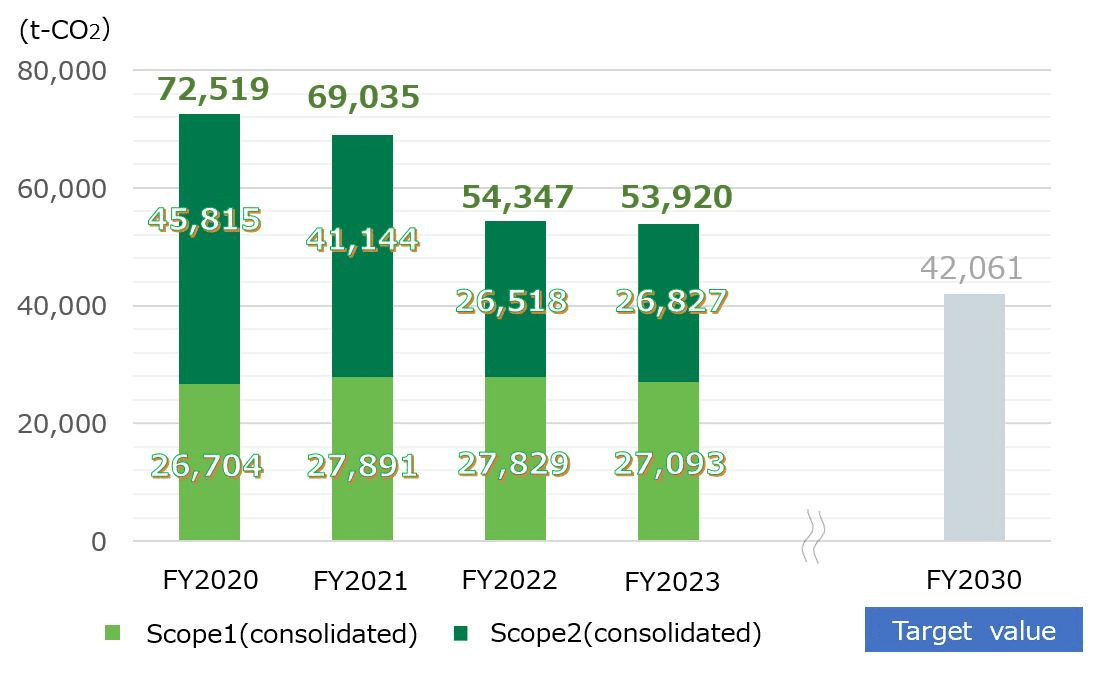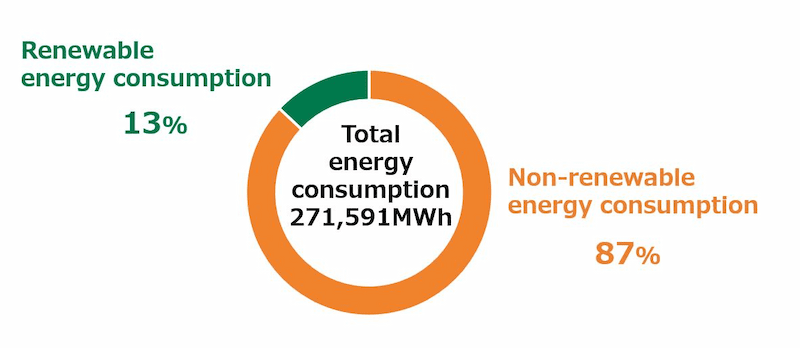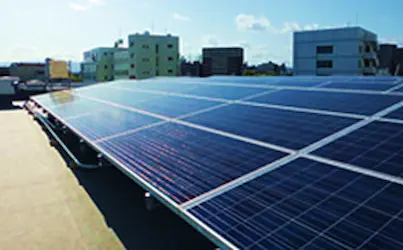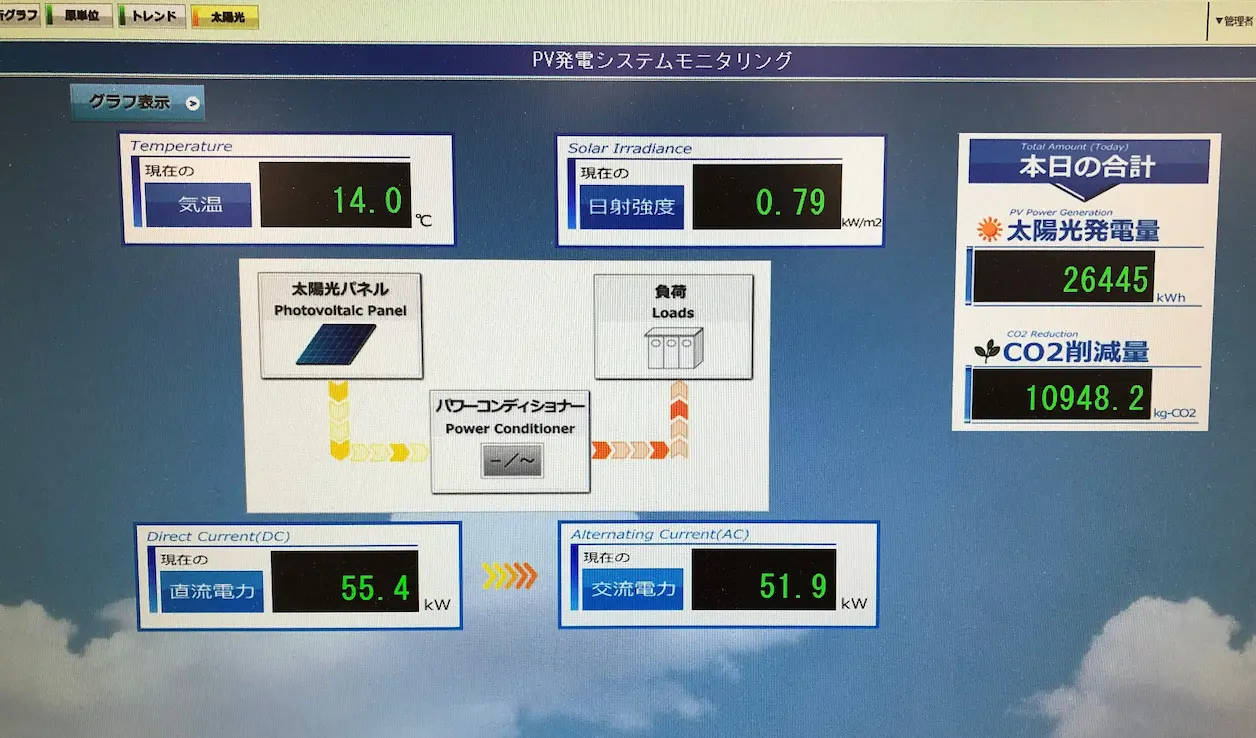Carbon Neutrality
Efforts to Save Energy and Reduce CO2 Emissions
Sumitomo Pharma aims to reduce greenhouse gas (GHG) emissions (Scope 1+2) to zero by fiscal 2050 through fossil fuel substitution. This will be achieved through the active use of energy saving and carbon dioxide eliminating technologies, which are expected to advance in the future, and renewable energy which is forecast to expand.
From fiscal 2023, we have set targets not only for Scope 1+2 but also for Scope 3, and have obtained approval
from the Science Based Targets (SBT) Initiative*1.
To achieve the Scope 1+2 targets, we will continue to introduce non-fossil energy sources such as renewable
energy-derived electricity, and systematically pursue capital investments that contribute to energy saving and
CO2 reductions through switching to LED lights and introducing energy-efficient facilities, taking
into
consideration the cost effectiveness in terms of CO2 reduction (yen/t-CO2) and the
payback period of each
measure. Following Oita Plant from November 2021 and Suzuka Plant from April 2022, we began purchasing
renewable energy-derived electricity at the Tokyo Head Office in April 2024.
For Scope 3, we will actively communicate with our suppliers to work together to achieve the target.
Additionally, we support the Japanese Government's policies in addressing global warming prevention, including the carbon neutral declaration, as well as relevant laws and regulations concerning energy saving and climate change. And we comply with the Act on Rationalizing Energy Use and Shift to Non-fossil Energy, the Act on Promotion of Global Warming Countermeasures, and the Climate Change Adaptation Act, and appropriately submit periodic reports to the government on energy consumption and other relevant information. Furthermore, in support of “Decokatsu*2 initiative which is being promoted by the government, we made the “Decokatsu” declaration in January 2024. We are actively raising awareness among our executives and employees by using the “Decokatsu” logo as well as the icons for Sustainable Development Goal 7 and 13. Each of us engages steadily in energy saving actions, such as thoroughly controlling air conditioning temperatures, reducing the use of air conditioners by dressing appropriately, and green driving.
- *1
Sumitomo Pharma Receives SBTi (Science Based Targets initiative) Approval
Press Release: https://www.sumitomo-pharma.com/news/20231110.html - *2 Decokatsu is a Japanese Government initiative to change people's behavior and lifestyles toward the achievement of the 2030 GHG emission reduction target and carbon neutrality in 2050 (https://ondankataisaku.env.go.jp/decokatsu/en/).

GHG Emissions (Energy Sources) Trends
The figure below shows the transition of emissions toward the target form fiscal 2023: "Reduce GHG emissions (Scope 1+2) by 42% (consolidated) compared to fiscal 2020 by fiscal 2030." As of fiscal 2024, a reduction of approximately 36% was achieved.

Trends in GHG emissions reduction target (consolidated) with FY2020 as base year
For information on the details of the calculation criteria, please see "ESG Data Table."
Proportion of Renewable Energy Use
In fiscal 2024, renewable energy comprised approximately 14% of total energy use. In addition, starting from fiscal 2024, we set a medium- to long-term target to "Increase the ratio of non-fossil electricity to 50% or more of total electricity use." As of fiscal 2024, the ratio has reached 45%, indicating steady progress toward the goal. We will continue to introduce renewable energy systematically to increase the proportion used.

Ratio of Renewable Energy Use (FY2024)
For information on the details of the calculation criteria, please see "ESG Data Table."
Solar Power Generating Systems
Sumitomo Pharma has installed solar power generation systems at our Central Research Laboratories and the Osaka Research Center and the total amount generated at both research facilities in fiscal 2024 was 141 MWh. The solar power generation is displayed real-time on a monitor screen inside the research building to enhance environmental awareness of the employees.

Solar panels on the roof of a Central Research Laboratories building

Solar power generation displayed real-time on a monitor screen
Non-Fossil Certificates
We utilize non-fossil certificates (26 MWh in fiscal2024) provided by DyDo DRINCO, Inc.*3 for the electricity consumption required to operate DyDo DRINCO's vending machines installed at our business sites. We will continue to value such collaborative opportunities with our business partners.
- *3 DyDo DRINCO, INC."LOVE the EARTH Vendors": https://www.dydo.co.jp/jihankiconsul/recommend/lte/ (in Japanese only)
Accounting of Emissions across the Supply Chain
We work to monitor GHG emissions across our entire supply chain. Our GHG emissions both by Scope and by Category (in Scope 3) are as shown in the table below. Our Scope 3 emissions decreased up to fiscal2024, which accounts for approximately 85% of our total Scope 3 emissions. We continue our efforts to collect primary data*4 for Scope 3 Category 1 emissions, including requesting GHG emissions disclosures from our major suppliers. To promote sustainability in the entire value chain, we have established the "Sustainable Code of Conduct for Business Partners," which sets five priority categories that we expect our business partners to work on, and have initiated the Sustainability Survey of our business partners from fiscal 2023. As for the environment, our business partners are requested to set targets for GHG reductions voluntarily and take actions to achieve them. Through collaboration with our business partners, we will continue working towards our consolidated target to reduce GHG emissions (Scope 3, Category 1) by 25% compared with fiscal 2020 by fiscal 2030.
For more details on the Sustainability Survey, please see "Together with Business Partners" and “Environmental Communications.”
- *4Compilation of primary data: Calculating emissions using data obtained directly from suppliers, etc., without using the database of emission intensity such as emission intensity contained in Ministry of the Environment DB
GHG Emissions by Scope
| Scope | Definition | CO2 Emissions (t-CO2)in FY2022 |
CO2 Emissions (t-CO2)in FY2023 |
CO2 Emissions (t-CO2)in FY2024 |
Boundary |
|---|---|---|---|---|---|
| Scope1 | Direct emissions of greenhouse gases from ourselves (fuel combustion, industrial processes) | 27,829 | 27,093 | 23,101 | Consolidated |
| Scope2 | Indirect emissions from the consumption of electricity, heating, cooling and steam supplied by other parties | 26,518 | 26,827 | 23,157 | |
| Scope3 | Indirect emissions other than those covered in Scope 1 and Scope 2 (emissions by other parties involved with the activities of our business) | 366,620 | 355,702 | 268,271 | Shown in the table below |
GHG Emissions by Category (Scope 3)
| Category | CO2 Emissions (t-CO2) in FY2022 |
CO2 Emissions (t-CO2) in FY2023 |
CO2 Emissions (t-CO2) in FY2024 |
Methods of Calculation and Emissions Intensity, etc. |
Boundary | |
|---|---|---|---|---|---|---|
| 1 | Purchased goods and services | 310,925 | 305,002 | 229,764 | Calculated by multiplying the purchase price of raw and packaging materials for products and purchased goods as well as manufacturing outsourcing costs by the emission intensity values stated in the DB of the Ministry of the Environment. | Non-consolidated basis |
| 2 | Capital goods | 24,134 | 18,623 | 14,740 | Calculated by multiplying the acquisition price of the fixed asset by the emissions intensity in Japanese Ministry of the Environment database | Consolidated |
| 3 | Fuel- and energy-related activities not included in Scope 1 or Scope 2 | 15,048 | 15,017 | 12,613 | Calculated by multiplying purchased electricity and steam by the emissions intensity in Japanese Ministry of the Environment database and purchased fuel by the emissions intensity in Carbon Footprint database or lifecycle inventory (LCI) database | Non-consolidated basis |
| 4 | Upstream transportation and distribution | 853 | 820 | 780 | Calculated by multiplying ton/kilometer for the transportation scenario by the emissions intensity in Japanese Ministry of the Environment database and LCI database | Transport in Japan, on a non-consolidated basis |
| 5 | Waste generated in operations | 3,655 | 4,563 | 900 | Calculated by multiplying the weight of waste according to type and processing method by the emissions intensity in Japanese Ministry of the Environment database | Plants, research laboratories, distribution centers on a non-consolidated basis |
| 6 | Business travel | 3,140 | 3,375 | 1,722 | Calculated by multiplying business travel expenses paid by the emissions intensity in Japanese Ministry of the Environment database | Non-consolidated basis |
| 7 | Employee commuting | 634 | 690 | 682 | Calculated by multiplying commuting cost according to transportation means by the emissions intensity in Japanese Ministry of the Environment database | Non-consolidated basis |
| 8 | Upstream leased assets | Not relevant | Not relevant | Not relevant | ー | ー |
| 9 | Downstream transportation and distribution | 5,305 | 3,672 | 3,132 | Calculated by multiplying CO2 emissions (estimate) per unit of sales in major pharmaceutical wholesaling by sales of our products in pharmaceutical wholesale segment | Non-consolidated basis |
| 10 | Processing of sold products | Not relevant | Not relevant | Not relevant | ー | ー |
| 11 | Use of sold products | 2,521 | 3,554 | 3,426 | Calculated by multiplying HFC amount in pharmaceutical MDIs (metered dose inhalers) sold by GWP | Non-consolidated basis |
| 12 | End-of-life treatment of sold products | 302 | 250 | 300 | Calculated by multiplying the weight of the container and packaging according to material based on "Containers and Packaging Recycling Law" by the emissions intensity in Japanese Ministry of the Environment database | Non-consolidated basis |
| 13 | Downstream leased assets | 103 | 136 | 212 | Calculated by multiplying the energy consumption of the building asset owned and rented out by the conversion factors based on "Greenhouse Gas Emissions Accounting, Reporting, and Disclosure System" which is provided in "Act on Promotion of Global Warming Countermeasures" | Non-consolidated basis |
| 14 | Franchises | Not relevant | Not relevant | Not relevant | ー | ー |
| 15 | Investments | Not relevant | Not relevant | Not relevant | ー | ー |
Japanese Ministry of the Environment database (Ver. 3.3 applied to fiscal 2022 emissions, Ver. 3.4 applied to fiscal 2023 emissions, Ver. 3.5 applied to fiscal 2024 emissions): The database on emissions unit values for accounting of greenhouse gas emissions, etc. by organizations throughout the supply chain
LCI database: LCI database IDEAv2 (for calculation of greenhouse gas emissions throughout the supply chain)
- Note:
- As for Category 9 (downstream transportation and distribution), figures for CO2 emissions of pharmaceutical wholesaling in fiscal 2023 were used for calculations of CO2 emissions in fiscal 2024, because CO2 emissions of pharmaceutical wholesaling in fiscal 2024 have not been released yet. As for total sales of pharmaceutical wholesaling and sales of our products in pharmaceutical wholesale segment, we used figures for fiscal 2024.
SBT(Science-Based Targets)
Our SBT are as follows.
- Reduce absolute Scope 1 and 2 GHG emissions 42% by fiscal 2030 from a fiscal 2020 base year (1.5℃ level)
- Reduce absolute Scope 3 GHG emissions from purchased goods and services 25% by fiscal 2030 from a fiscal 2020 base year (Well below 2℃ level)
We are making steady progress on the Scope 1+2 target, with a 36% reduction compared to fiscal 2020.
For the Scope 3 target, due to significant changes in the composition of our products, the calculation based
on secondary data showed an approximately 44% increase. However, on a standalone basis, our emissions have
decreased by 33% compared to fiscal 2020.
Going forward, we will actively collaborate with suppliers to reduce GHG emissions and promote the use of
primary data to better reflect the actual emissions.
Partnership Initiatives
Partnership with Federation of Pharmaceutical Manufacturers' Associations of JAPAN
We participate in activities of the Federation of Pharmaceutical Manufacturers' Associations of Japan (FPMAJ) through our membership in the Japan Pharmaceutical Manufacturers' Association (JPMA), an FPMAJ member. FPMAJ is member of the Japan Business Federation (KEIDANREN), which supports the Japanese Government's "2050 Carbon Neutral Declaration," has expressed its determination to work together with the Government to achieve it and drawn up a "Carbon Neutral Action Plan." Based on this action plan, FPMAJ has set the long-term vision of the Carbon Neutral Action Plan for the pharmaceutical industry as "achieving net-zero CO2 emissions by 2050" and established the Phase II target of "reducing CO2 emissions by 46% (research laboratories, plants, offices, and sales vehicles) from fiscal 2013 level by fiscal 2030," and is thus promoting the reduction in CO2 emissions. We are also participating in and proactively working to advance this action plan.
Also, in line with Japanese Government policy, FPMAJ is working on reducing emissions of chlorofluorocarbons, which are also GHGs, and has established "Chlorofluorocarbon Study Subcommittee," a specialist subcommittee. The subcommittee has drawn up a voluntary action plan including numerical goals and in addition to carrying out activities to control emissions of chlorofluorocarbon substitutes (HFCs) used in quantitative spray aerosols is supporting policy execution through regular reporting to the Industrial Structure Council of the Ministry of Economy, Trade and Industry. Since Sumitomo Pharma imports and sells Qvar®, an inhaled steroid asthma therapy containing HFC-134a as a propellant, we participate in subcommittee efforts to reduce HFCs and collaborate with the regulatory authorities.
Participating in Japan Climate Initiative
Japan Climate Initiative (JCI) is a network of companies, local governments, NGOs and others in Japan that actively tackles climate change with an aim to strengthen information dissemination and information exchange to realize a decarbonized society. In an endorsement of JCI's declaration that it is "Joining the front line of the global push for decarbonization from Japan," Sumitomo Pharma has been participating since October 2018. By publishing messages and sending letters to the Government, JCI has been seeking stronger measures against climate change. Sumitomo Pharma endorses the following JCI messages.
- "Long-term Strategy Demonstrating Japan's Leadership in Achieving a Decarbonized Society to the World" published on May 16 2019*5
- "JCI Message to the Japanese Government Calling for Ambitious 2030 Goals to Realize the Paris Agreement" published on April 19 2021*6
- "Now is the time to accelerate renewable energy deployment -Calling for stronger climate change action in the midst of the fossil energy crisis-" published on June 3, 2022*7
- "Overcoming Two Crises with Renewable Energy and Carbon Pricing" published on April 12, 2023*8
- "Japanese non-state actors call for an ambitious 2035 target that is consistent with the 1.5 ℃ goal" published on July 8, 2024*9
- *5https://japanclimate.org/english/news-topics/messageonlongtermstrategy_en/
- *6https://japanclimate.org/english/news-topics/call-for-ambitious-2030-target/
- *7https://japanclimate.org/english/news-topics/jci-message-re-release/
- *8https://japanclimate.org/english/news-topics/jci-message-g7-release/
- *9https://japanclimate.org/english/news-topics/jci-message-2035ndc-release/